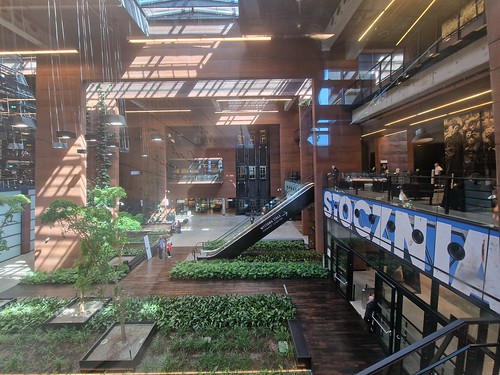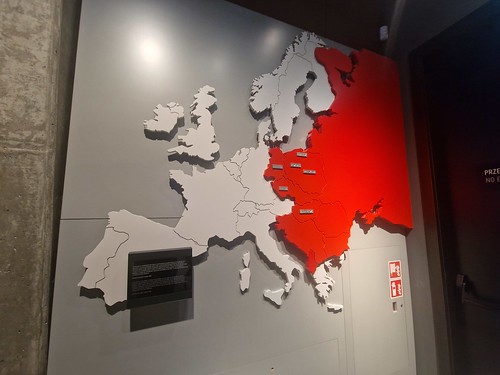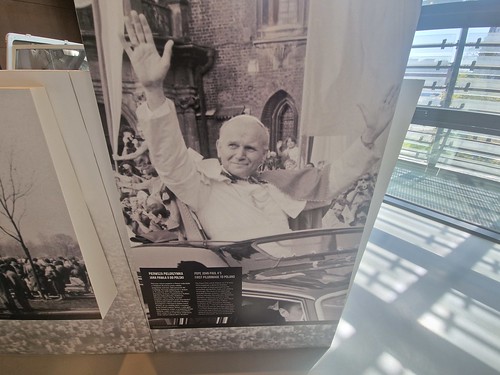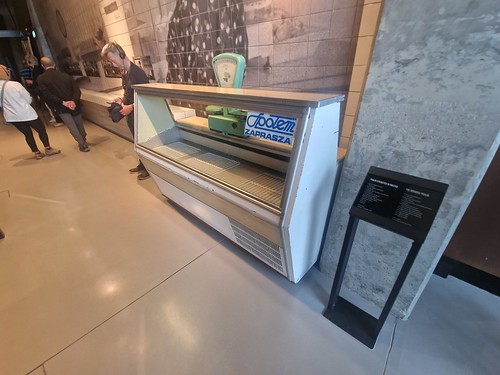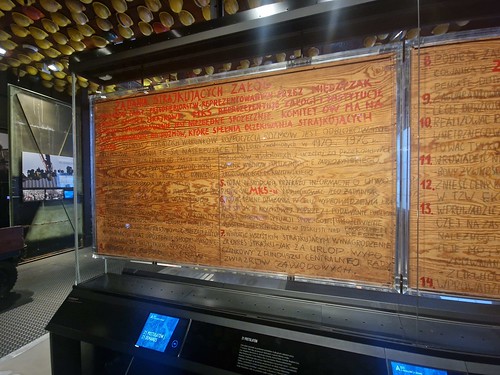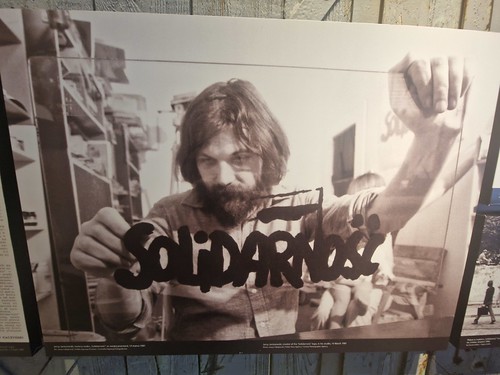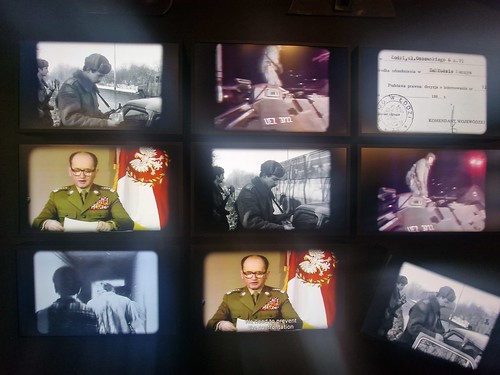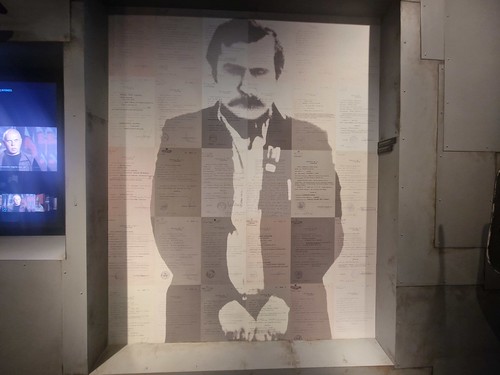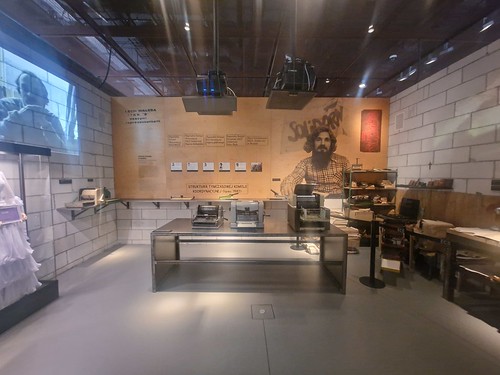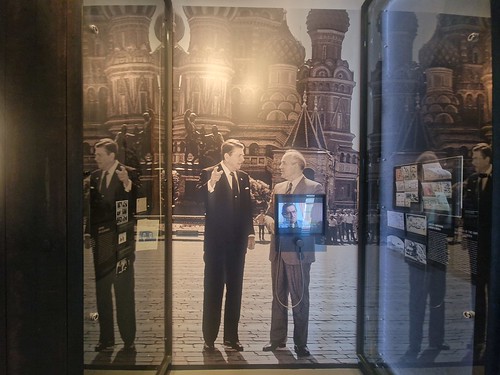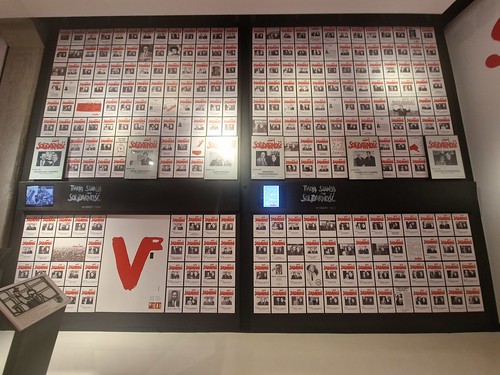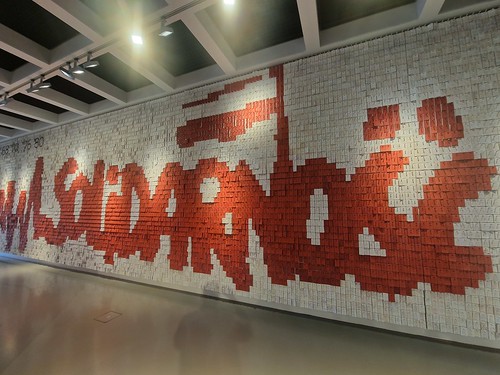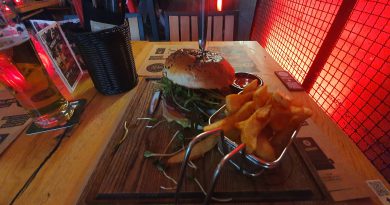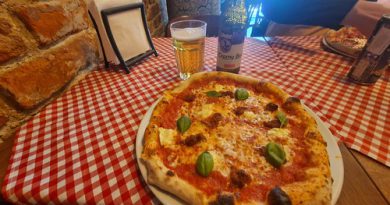Gdansk Group Trip – Day 3 (Solidarity Museum)
This is my second visit to the Solidarity Museum in Gdansk, which tells the story of the political and civil resistance of the brave people of Poland against the oppressive communist regime. The museum, which is also a library and academic centre, opened in 2014 and the exterior is designed to look like the hulls of ships as this is where the movement came from, the Gdansk Shipyards.
The grand and expansive lobby of the museum.
The Soviets liked to pretend that there was a closeness between the people of their country and Poland, with Leonid Brezhnev, the Soviet President between 1964 and 1982, and Edward Gierek, the Polish President between 1970 and 1980, continuing that farce in this photo. I think it’s fair to say that the majority of the people of Poland aren’t feeling much closeness with Russia today.
This was the reality for anyone who opposed people such as Gierek, they were thrown in prison. As a political leader, Gierek was seen as relatively reforming and modernising, but he presided over economic chaos and political suppression.
The map of Soviet influence fortunately doesn’t look like this any more.
There are the heroes of Poland in my view, the brave men and women who stood up and argued against the policies of the state. They were arrested, often beaten and their careers destroyed.
This is the shirt of Adam Gotner who was shot at an earlier protest on 17 December 1970, the bullet hole is visible, but he survived.
Things would have been much better if someone like Steve, a modernising and forward-thinking individual, had been involved with matters.
Not that it’s relevant for this blog, but I have some deep concerns about the current Pope, but it’s certainly fair to say that Pope John Paul II was a pivotal figure in the fight against communism and intolerance in Poland. He remains a hero for many in Poland, not least for how he spoke to and for the people of the country in the 1980s. The Polish Government at the time were not impressed at his involvement I think it’s fair to note.
The Popemobile.
The realities of communist economic policy, there were product shortages and long queues.
The 21 demands issued by the strike committee on 17 August 1980. These boards were placed on the Maritime Museum following the protests, but then hidden by a museum worker when the army took over the running of the country and they were later rediscovered and moved to this museum when it opened. And, for completeness, here are their demands:
1. Acceptance of free trade unions independent of the Communist Party and of enterprises, in accordance with convention No. 87 of the International Labor Organization concerning the right to form free trade unions.
2. A guarantee of the right to strike and of the security of strikers.
3. Compliance with the constitutional guarantee of freedom of speech, the press and publication, including freedom for independent publishers, and the availability of the mass media to representatives of all faiths.
4. A return of former rights to: 1) People dismissed from work after the 1970 and 1976 strikes. 2) Students expelled because of their views. The release of all political prisoners, among them Edmund Zadrozynski, Jan Kozlowski, and Marek Kozlowski. A halt in repression of the individual because of personal conviction.
5. Availability to the mass media of information about the formation of the Inter-factory Strike Committee and publication of its demands.
6. Bringing the country out of its crisis situation by the following means: a) making public complete information about the social-economic situation. b) enabling all social classes to take part in discussion of the reform programme.
7. Compensation of all workers taking part in the strike for the period of the strike.
8. An increase in the pay of each worker by 2,000 złoty a month.
9. Guaranteed automatic increases in pay on the basis of increases in prices and the decline in real income.
10. A full supply of food products for the domestic market, with exports limited to surpluses.
11. The introduction of food coupons for meat and meat products (until the market stabilizes).
12. The abolition of commercial prices and sales for Western currencies in the so-called internal export companies.
13. Selection of management personnel on the basis of qualifications, not party membership, and elimination of privileges for the state police, security service, and party apparatus by equalization of family allowances and elimination of special sales, etc.
14. Reduction in the age for retirement for women to 50 and for men to 55, or (regardless of age) after working for 30 years (for women) or 35 years (for men).
15. Conformity of old-age pensions and annuities with what has actually been paid in.
16. Improvements in the working conditions of the health service.
17. Assurances of a reasonable number of places in day-care centers and kindergartens for the children of working mothers.
18. Paid maternity leave for three years.
19. A decrease in the waiting period for apartments.
20. An increase in the commuter’s allowance to 100 złoty.
21. A day of rest on Saturday. Workers in the brigade system or round-the-clock jobs are to be compensated for the loss of free Saturdays with increased leave or other paid time off.
The strike committee evolved into the Solidarity movement, the logo was created by Jerzy Janiszewski.
The almost comedy announcement, although it had serious implications for Poland, made in 1981 by Wojciech Jaruzelski when he said that martial law was required because of Solidarity. He was the Prime Minister of Poland between 1981 and 1985 and personally responsible for crimes against the people of the country, but he avoided criminal action due to ill health and he died in 2014. In his later years he apologised for the failures of communism and said he had reformed, but I’m not sure how widely that was believed.
The leader of the strike movement, Lech Wałęsa, the future President of Poland.
The Polish authorities didn’t like the rise of Lech Wałęsa and Solidarity.
Although printing political document for Solidarity was banned, illegal printing presses sprung up around the country.
Ronald Reagan visiting Moscow on 31 May 1988.
A recreated circular table from the Polish Round Table Agreement of 1989.
The Solidarity election posters ready for the 4 June 1989 elections and they won every single Senate seat.
Candidates for the party wanted to appear linked to Lech Wałęsa, so he appeared in just about every election leaflet.
Communism collapsed, Poland was free once again thanks to Solidarity and the people behind the movement.
It’s a fascinating museum, telling the story of how Solidarity was born, where it came from and the influence which it now has. There’s a viewing platform on the top of the building where it’s possible to see the docks and where Solidarity was born. Steve was told off for walking on the gravel, but Ross and I carefully walked just on the paving stones. I think Steve would have been a radical if he had worked at the docks….
It’s a definitely a museum worth visiting, I think we all enjoyed it and found it useful. It’s not hard to feel great sympathy for the Polish people seeing what they’ve been through in the twentieth century, their country smashed apart by war and then left in economic and political chaos by the communist authorities. Things feel and look so much more positive now, but it needed the bravery of these men and women of the Gdansk shipyards, and far beyond, to start that change. I have more to note about this museum, but for the purposes of vaguely trying to keep up with the blog this weekend, I’ll limit myself to that.

